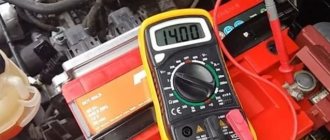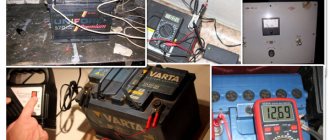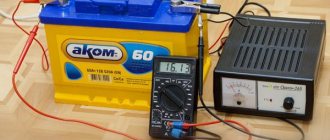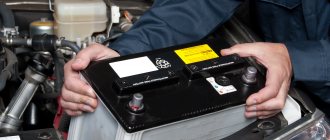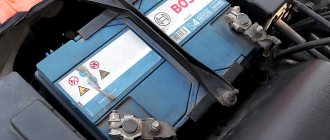If a battery that is more than 5-7 years old is not charging , then the answer to the question is: “ why ?” most likely lies on the surface. After all, any battery has its own service life and over time loses some of its basic performance characteristics. But what if the battery lasted no more than 2 or 3 years, or even less? Where then should we look for reasons why the battery does not want to charge? Moreover, this situation occurs not only when recharging from a generator in a car, but even when it is replenished from a charger. Answers must be sought depending on the situation by performing a series of checks followed by procedures aimed at eliminating the problem.
Most often, you can expect 5 main reasons that manifest themselves in eight different situations:
| Situation | What to do |
| Oxidized terminals | Clean and lubricate with special lubricant |
| Broken/loose alternator belt | Stretch or change |
| The diode bridge has failed | Change one or all diodes |
| Voltage regulator faulty | Replace graphite brushes and the regulator itself |
| Deep discharge | Increase the charging voltage or reverse polarity |
| Incorrect electrolyte density | Check and adjust to the required value |
| Sulfation of plates | Perform a polarity reversal, and then several cycles of full charge/discharge with low current |
| One of the cans is closed | Actions to restore a battery with such a defect are ineffective |
To understand in detail all the possible malfunctions due to which the car battery does not charge, first of all, clearly define the situation:
| The battery quickly discharges and dies | or he | does not charge at all (does not accept charge) |
In general, when the battery refuses to charge, the following options are allowed:
- plate sulfation;
- destruction of plates;
- terminal oxidation;
- decrease in electrolyte density;
- short circuit
But you shouldn’t worry so much right away, everything is not always so bad, especially if such a problem arose while driving (indicated by a red battery light). It is necessary to consider special cases in which the car battery does not take charge only from the generator or from the charger as well.
Please note that sometimes the battery, although fully charged, runs out very quickly. Then the reason may be hidden not only in its failure, but primarily due to current leakage! This could happen through: lights not turned off, interior lighting or other consumers and poor contact at the terminals.
The charging system of a car battery contains a number of external devices, on which the performance of the battery itself and the charging process can also greatly depend. To check all external devices, you will need a multimeter (tester); it will allow you to measure the voltage at the battery terminals under different engine operating modes. You will also have to check the generator. But this is only true when the battery does not want to be charged from the generator. If the battery does not take a charge from the charger, then it is advisable to also have a hydrometer to check the density of the electrolyte.
The battery does not charge from the generator . The first signal that the battery is not charging is a lit red battery light! And to make sure of this, you can check the battery voltage. There should be 12.5... 12.7 V at the battery terminals. When the engine is started, the voltage will rise to 13.5... 14.5 V. With consumers turned on and the engine running, the voltmeter readings, as a rule, jump from 13.8 to 14.3V. No changes on the voltmeter display or when the indicator goes beyond 14.6V indicates a generator malfunction.
When the generator runs but does not charge the battery, the cause may lie in the battery itself. Apparently it was completely discharged, which is called “zero”, then the voltage is less than 11V. A zero charge may occur due to sulfation of the plates. If the sulfation is insignificant, you can try to eliminate it. And try charging using a jump charger.
This is interesting: The causes of brake pad wear will be:
How to understand that the battery is not charging from the charger ? When a battery is connected to a charger, evidence that it is fully charging is a constantly changing voltage at the terminals and jumping voltage or current readings on the device dial. If there is no charge, there will be no change. When the battery is not being charged from an Orion type charger (which has only indicators), you can very often observe a buzzing and rare blinking of the “current” light.
Frequent reasons when the battery does not charge from the generator are:
- Oxidation of battery terminals;
- Stretched or broken generator belt;
- Oxidation of wires on the generator or vehicle ground;
- Failure of diodes, voltage regulator or brushes;
- Sulfation of plates.
How to find out if the battery is not taking a charge
You can check when the battery is not charging by checking the operation of all electrical equipment in the car. So, when the engine is running, the battery is powered by the generator. However, very often, even with a properly functioning generator, the battery remains discharged. How can you tell if the battery has power?
Everything is simple here - just measure the voltage at the battery terminals with a multimeter. If it does not want to charge, the tester screen will show a value of 12 V or lower. If the battery is functioning correctly, then the result will be at least 14 V. These tests are carried out with the engine running - otherwise it will not be possible to take measurements.
If it is impossible to start the engine due to a dead battery, then using a multimeter you can look at the voltage level at the battery terminals. If the value on the tester screen is less than 11.8 V, this will indicate that the charge is minimal. If the voltage readings are 12.8 V, the battery is fully charged.
If you connect the battery to a charger, it will be fully charged. The voltage at the battery terminals will constantly change. If at the beginning of the process an increase in voltage was noticed, and then the indicators stopped at the same level, it means that the battery is fully charged. But this doesn't always happen. If the voltage level has not changed since connecting to the device, then the battery does not take charge from the charger. You should start looking for the reasons that led to this.
Devices for identifying the problem
The battery charge level (including low) is determined with special devices: a multimeter or a hydrometer.
Before diagnostics, you need to warm up the car and recharge the battery, driving about 20 km. Measurements are taken immediately, before the battery has cooled down.
The procedure for measuring the level (low charge) with a multimeter
Set the switch to DC current measurement mode up to 20 Volts, connect the terminals. The charge of a working battery at a temperature of 20 °C should be at least 12.6 Volts. All values below indicate a malfunction.
A hydrometer measures the density of the electrolyte extracted from each section of the battery. Its value should not be less than 1.26 g/cm. cube
The difference in density between sections should not exceed 0.02 g/cm. cube Not all batteries have plugs for collecting chemical liquid, so their charge can only be measured with a multimeter.
List of obvious reasons
Just realizing that something is wrong with the battery is not enough. You still need to be able to understand the causes of this malfunction. It should be emphasized that in various cases the battery, despite the fact that it is fully charged, can very quickly lose voltage. This indicates that there are current leaks in the vehicle's on-board network. They must be found and eliminated.
If the reason is in the battery, then in most cases the so-called sulfation of the battery plates has occurred. A white coating grows on them. This is lead sulfate that has crystallized into large deposits. Minor sulfation can be eliminated. If large enough areas of the plates are damaged, the battery cannot be restored.
If the car battery and charger fundamentally do not charge, then the reasons may be oxidized terminals, a broken drive belt, or damaged wires.
Other causes of non-charging or poor battery charging
If, when trying to charge a dead battery from a charger, the car owner does not get the desired result, or the charging was not complete within a certain time, and the above tips did not help, then your actions will depend on the specific situation. Let's consider each case in detail.
In a discharged battery, the electrolyte density does not correspond to the norm
The density is checked with a hydrometer in each jar. For temperate regions, it should be 1.27 g/cm 3, at +15 0 C. At a normal level, the density increases during charging. If the density does not increase in a bank or several banks, the battery does not take a charge. The fact that not everything is in order with the electrolyte is indicated by its cloudiness - in its normal state it is transparent and colorless.
Proceed in the following sequence.
- Observing safety precautions, drain the cloudy liquid.
- Rinse the desired jars with distilled water.
- Fill in new electrolyte, bring the density to normal.
- Recharge until normal density is achieved in all banks.
- Monitor the optimal electrolyte level and add distilled water if necessary.
It is better to wash the cans by an experienced specialist to prevent short-circuiting of the positive and negative electrodes.
Short circuit in plates
Difficulties with charging from the charger can occur when the plates short-circuit, which occurs when they fall off. In this case, lead particles settle to the bottom and come into contact with the lower ends of the electrodes.
Another possible problem is wear of the separators, in which case the positive and negative electrodes come into contact and a short circuit occurs. In addition, the positive and negative electrodes can become deformed for various reasons and short out the circuit.
If the battery design allows, the banks are repaired. Otherwise, the power supply must be replaced.
Sulfation of battery plates
The phenomenon when a white coating covers the electrodes is called sulfation. It appears if the battery has not been recharged for a long time, the water has evaporated, and the density of the electrolyte has increased. As a result, it is possible that the battery is not fully charged.
The battery may not take a charge even if the seal of the case is broken. If its integrity is violated, distilled water evaporates and the density of the electrolyte increases, with all the ensuing consequences. What to do in this case? To identify a possible defect, if it is minor, it is possible to restore the tightness by gluing or soldering with plastic. Restoring the integrity of the case is carried out without electrolyte, with a dry container.
It is possible to keep your car battery in working condition without it reaching the point where it won’t take a charge if you strictly follow the rules in the owner’s manual. Requires periodic recharging and keeping it clean.
Broken generator drive belt
If your car battery won't accept a charge from the alternator, the alternator drive belt is often to blame. He could have simply snapped. Sometimes even a slight loosening of the belt on the pulley can lead to the same result. The generator does not produce enough power, the battery does not charge. This happens due to natural wear and tear of the element or its stretching.
The generator belt can not only stretch, but also slip on the pulleys. Sometimes this happens due to water getting on the surface of the pulley.
Voltage regulator malfunction
Problems with the voltage regulator are rare, and only specialists can fix them. Due to constant changes in the crankshaft speed, the voltage created by the generator begins to “float”. The purpose of the regulator is to align it in accordance with the required standard. The failure of this element invariably leads to the fact that the battery begins to “suffer” from too low or, conversely, high voltage. Which negatively affects the service life of the battery.
Oxidized wires on the generator
If the battery does not take a charge, the reason may also be oxidized wires on the generator. In this case, the situation can be corrected by stripping the wires. As in the previous case, sandpaper is used for this.
But in addition to oxides, the generator wires can burn out or break. They burn out most often due to a voltage drop. The characteristic burning smell will help determine this. In this case, simply replacing the wires is not enough. You must first eliminate the cause, because after replacement, new elements can also burn out. It is worth remembering about self-discharge - the battery gradually discharges if it is not used. These are completely normal natural processes.
If the battery does not take current from the charger
There are a number of external devices for charging batteries, on which the battery charging process may depend. The same tester will help to check the functionality of external equipment. They measure the voltage at the battery terminals. But now the test is performed with the engine turned off and the wires disconnected.
A voltage in the range from 12.5 to 12.7 V can be considered normal. If, after the battery is connected and the engine is started, the voltage does not rise to 13.5-14 V, try increasing the engine speed and then observe whether it changes terminal voltage. If a voltage drop is noticeable at high speeds, the cause may be diodes in the generator regulator relay. It is also useful in a situation where the battery does not take a charge to assess the condition of the generator brushes. They are subject to natural wear and tear during operation.
The diodes can be replaced separately or a completely new relay can be installed. The diode passes voltage, if it is in normal condition, only in one direction. If the current flows in both directions, it means the element has failed. It should be borne in mind that to replace these diodes you need a soldering iron with a power of 600 W or more and some experience in handling it.
After replacing the diodes, it is necessary to observe their operation. If they heat up when the engine starts, too much current is supplied to the battery, which is undesirable and even harmful for the battery. In addition, if the temperature is high, the diode cannot last long enough. Therefore, if the reason is still in these parts, it is easier to replace the entire relay completely.
Car generator malfunctions
When the engine starts running, two indicator lights (red or orange) must light up on all machines. One of them is responsible for the battery, and the other shows the level of oil pressure in the internal combustion engine itself. Both lights stop lighting after the engine starts. But if the battery indicator remains on, it gives the driver a signal that the battery is not receiving electricity from the local current generator , the main function of which is to recharge it while driving.
There may be several possible types of malfunctions due to which the generator does not charge the car battery.
Let's first list them, and then look at each one individually:
- belt drive broke;
- The generator brushes are worn out and need to be replaced.;
- the relay is broken;
- copper stator winding broke.
The generation of electrical energy to recharge the battery on the go occurs in a very simple way. The generator axis, by rotating together with the drive gear, operates on the principle of a conventional electric motor. The axis rotates and electricity is generated. If at least one link of this “belt chain” breaks, the shaft does not rotate and the battery from the generator does not charge.
Alternator brushes also wear out over time. They are located on one side of the generator shaft and help it generate electricity. If they fail, no current flows to the battery either. There is only one way out: replace the old brushes with new ones .
The relay provides a constant current supply to avoid sudden changes in U. If the relay breaks, the battery will not receive electricity to recharge . The relay is also easy to replace.
If the copper winding of the stator shaft is broken, this is another reason why the battery is not charging from the generator. You need to keep in mind that it is much easier to replace the relay and its brushes yourself (of course, with a certain skill). But if the reason lies precisely in the stator shaft, it is better to contact a professional auto repair service with this problem. In this case, the generator will have to be completely disassembled.
Battery malfunctions and their elimination
At the beginning we already talked about sulfation. But there are other problems with the battery itself. This is the last thing to check if the battery does not take a charge. What to do in this situation? The problem needs to be eliminated. To eliminate sulfation of the plates, it is recommended to rinse the battery with distilled water. The inside of the battery is first cleaned of debris. The battery is then allowed to dry completely before being charged if possible.
The electrolyte density is adjusted to 1.2885 g/cm3. A liquid with a density of 1.4 g/cm3 is suitable for this. Do not allow the electrolytic fluid to boil or heat. The charging process is continued until the charge in each section is 1.3-1.4 V. Then the current is halved, but charging should continue. If after two hours the voltage and density do not change, the process is stopped. Water and electrolyte are added to the battery. The voltage in each section is reduced to 1.7 V using a light bulb.
After this, the battery should start working properly. But in addition to sulfation, the plates can be destroyed. In this case, the electrolyte will turn black. The plates often short out. This will be indicated by the absence of electrolytic fluid in any section. When shorted, it gets very hot. You will hear a characteristic hissing sound. When you open the lid, you will see the electrolyte boiling and bubbling.
Problems with your phone or charger
Dust, debris or oxide
With intensive use of the device, contamination or oxidation of the contacts both for connecting the battery and for connecting the charger is almost inevitable. First of all, remove the back cover, take out the battery, if possible, clean the contacts. We do the same with the USB output, and also check to see if any debris has gotten into it.
Mechanical damage
We took out the battery and are looking at it carefully. If there are bulges or the battery is swollen, replace it immediately and never connect it to the mains.
Comparison of normal and swollen batteries
We look carefully at the USB output. If there is any physical damage, same thing, replace it. If the tongue is slightly beveled or bent, you can try to return it to the desired position with a flat-head screwdriver or other similar tool.
If a problem with charging appears after mechanical damage, such as a fall or impact, then most likely you will have to take the device to a specialist service center.
Charger
Usually, if the phone battery does not charge, they blame the charger, and not without reason. Simple damage to the wire may force you to buy a new cable or charger. The charger itself may burn out, and this often happens, but there are some nuances.
It is advisable to charge Android with a native charger
If for some reason you are using a non-native device that produces an insufficient number of amperes, then your battery will inexorably lose charge until it is completely discharged, but more on that later. In the most general case, use either a native charger or a similar one, pay attention to the output current.
If everything looks fine with the charger and the current strength is suitable for our phone, then we try to charge another phone with it. Depending on the success of what has been done, we either read the article further or change the charger.
Also, the smartphone may not charge well and even lose charge while on charge if its processor is too loaded. It’s worth turning off Wi-Fi and closing applications, especially heavy ones. When charging, you don't need to play or watch movies at the same time. If the charger does not provide more current, it can lead to discharge and is also harmful to the battery.
